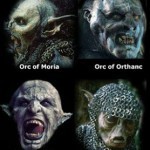We’re getting far enough along now that we’re looking at our cast of characters and trying to figure out who’s needed and who needs to go; who we’re missing and who we wouldn’t miss if they walked off the page and never came back. My theory of character casts is that you basically have four kinds of characters. This is not a rule, it’s not even a tool. It’s just the way I sort characters.
So four kinds of characters.
1. The Good Guys
This is my protagonist and the people who will die for her. It’s usually a short list, and includes her best friend, her love interest, and possibly one or two others. If everybody is willing to go to the mat for Our Girl, she’s not in any danger. This is why so many romance heroines are orphans.
So for this book, it’s Cat and Keely, our two protagonists, and Harry and Rafe, the love interests/protagonists of the major subplots.
2. The Bad Guys
Otherwise known as the antagonist and his or her minions (minions, heh), the key here is that they out-man and out-power the Good Guys.
Our anatgonist and minions will remain a secret for now. But at the moment there are three of them and one dies in Act Three, so that’s not good. The more minions, the more danger our Good Guys are in.

And the minions have to be powerful. Good hearted twinkies in goggles won’t do it.

The Support Staff
These are the people whose actions influence the plot in important ways, important enough that taking them out would cause damage to the plot. Not cause the plot to collapse, they’re support not main players, but they’re necessary to the story. At last count, we had eleven of those, but stay tuned, we’re not done yet.
The Wallpaper
These are the people who act as setting. If your protagonist is a waitress, she’s going to be working with other waitresses, bus boys, cooks, talking with repeat customers. You need these people as setting, to show how she interacts with her setting, but if one of them walks off the page, no story will be lost. So far we have twelve with names.
Think of the protagonist/antagonist characters as the framework of a building, the part that makes an empty space a structure. Then the support people are drywall; you put a hole in that, you’re gonna have to use some spackle, but the house won’t fall down. And then the setting people are wallpaper; they have no structural role whatsoever, they’re just decoration.
The key, then, is to make sure your major structure is strong and balanced (there’s that conflict box), and that you haven’t drywalled over a door or added an extra layer that makes the structure difficult to navigate, and that the wallpaper doesn’t make the place so busy that people can’t find the light switches.
I think I’ve run that analogy into the ground, so let’s just leave that there.
So at this point we’re looking at protagonist/antagonist balance, and the roles of the support players, making sure they really are necessary to the plot. The wallpaper is the easy part: just don’t call so much attention to them that people think they’re going to be important later, as in, stop describing them in detail. (Reminds me of collaborating with Bob; when I told him he was going to have to stop killing people because it would upset readers who’d become attached to them, he said, “Then stop giving them names.”)
It’s a fine line to walk: put in enough characters so the main characters are living in a fully formed world without putting in so many people that the key players get lost in the crowd which pulls the reader out as she tries to figure out who the hell Rebecca is. (Rebecca must be important, she has black hair, blue eyes, and a name!)
And then there’s the problem of the supporting character who becomes more interesting than the protagonist or antagonist (I wrote this dog named Fred once . . .) so you have to go back and make sure your Good Guys are GREAT Guys . . . .
Peopling your stories is a lot more than making character lists, but making character lists can help keep your people from overrunning your stories.

 newest »
newest »
 newest »
newest »
 Reading your blog yesterday, I discovered a writer whose books are right up my alley, Lani Diane Rich. Time Out For Good Behavior is hilarious and I've only read a few chapters.
Reading your blog yesterday, I discovered a writer whose books are right up my alley, Lani Diane Rich. Time Out For Good Behavior is hilarious and I've only read a few chapters.







